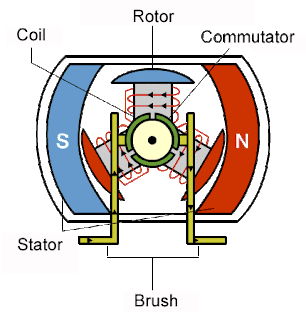The
article Introduction of How A Brushless DC Motor Works explains how brushless
dc motor for sale works. In a typical dc motor, there are permanent magnets
on the outside and a spinning armature on the inside. The permanent magnets are
stationary, so they are called the stator. The armature rotates, so it is
called the rotor. The armature contains an electromagnet. When you run
electricity into this electromagnet, it creates a magnetic field in the
armature that attracts and repels the magnets in the stator. So the armature
spins through 180 degrees. To keep it spinning, you have to change the poles of
the electromagnet. The brushes handle this change in polarity. They make
contact with two spinning electrodes attached to the armature and flip the
magnetic polarity of the electromagnet as it spins.
 |
This
setup works and is simple and cheap to manufacture, but it has a lot of
problems:
- The brushes eventually wear
out.
- Because the brushes are
making/breaking connections, you get sparking and electrical noise.
- The brushes limit the
maximum speed of the motor.
- Having the electromagnet in
the center of the motor makes it harder to cool.
- The use of brushes puts a
limit on how many poles the armature can have.
With
the advent of cheap computers and power transistors, it became possible to
"turn the motor inside out" and eliminate the brushes. In a brushless
dc motor (bldc), you put the permanent magnets on the rotor and you move the
electromagnets to the stator. Then you use a computer (connected to high-power
transistors) to charge up the electromagnets as the shaft turns. This system
has all sorts of advantages: Because a computer controls the
motor instead of mechanical brushes, it's more precise. The computer can also
factor the speed of the motor into the equation. This makes brushless motors
more efficient.
·There is no sparking and much
less electrical noise.
·There are no brushes to wear out.
·With the electromagnets on the
stator, they are very easy to cool.
·You can have a lot of
electromagnets on the stator for more precise control.
An
electric motor is all about magnets and magnetism: A stepper motor for sale uses magnets to
create motion. If you have ever played with magnets you know about the fundamental
law of all magnets: Opposites attract and likes repel. So if you have two bar
magnets with their ends marked "north" and "south," then
the north end of one magnet will attract the south end of the other. On the
other hand, the north end of one magnet will repel the north end of the other
(and similarly, south will repel south). Inside an electric motor, these
attracting and repelling forces create rotational motion. The motor being
dissected here is a simple electric motor that you would typically find in a
toy.




No comments:
Post a Comment